We talked about the basics of wave energy generation in my last post. Unfortunately, you'll need to read it to understand this post. So if you are a new reader, here are the links to previous posts.
Take your time, no need to hurry. This post is on a blockchain, it's not going anywhere as long as humanity has internet, lol. I'll try to make it as easy as possible, even for a first timer. You can open the above posts in new tabs if you still need a quick reference while you are reading this one.
Today, we'll start looking at some of the design ideas that are proposed to harness the ocean wave energy. Easiest way to describe all such devices would be to divide them into different categories, and then each category differently.
Different devices are designed with different working principles (that’s why they work differently). A division based on working principle and design seems like the easiest way to talk. So let's begin.
Note: A lot of details are sacrificed for the sake of keeping things simple and easy to understand.
There are only three basic kinds of designs. All the ocean wave energy generation devices in various stages of development can be divided and talked about as three simple categories... Now this got easier, right?
1. Oscillating Water Column Devices (OWC devices)
We know that particles in every wave move in a specific manner, they oscillate. So an oscillating water column is simply half the wave (since it spans half the wavelength of a wave) in ocean water. gif1.
Oscillating water column or simply OWC devices are a designed to uses this up and down motion of water to power a wind turbine. How is this achieved? Let's take a look at their design.
These devices are always located above the ocean surface. This one is obvious, how are we supposed to drive a "wind" turbine if it is located in water? Plus point in this case is - these devices are harmless to sea life. The minus point is, the device is a bit noisy, thanks to the turbines. OWC devices are therefore located as farther from the shore as possible. But this noise too can be minimized. Hanna Turbine is actually designed as a concealed device, which helps with noise pollution as well.
The working is simple. A chamber with a wind turbine is located above the water column. As the water rises, air is pushed out of the chamber, and as it falls, air is sucked back in. This movement of air drives our turbine. But wait, if the air flow in one direction (say outward) rotates the turbine in one direction (say clockwise), shouldn't the turbine rotate in opposite direction when the flow reverses? A turbine only has blades after all, right? Well, for any normal turbine, air flow in opposite direction (inward) would obviously cause an (say anti-clockwise) rotation. Or at least resist the clockwise movement of the turbine, thus making it inefficient.
But our turbine is special. It is a bidirectional turbine.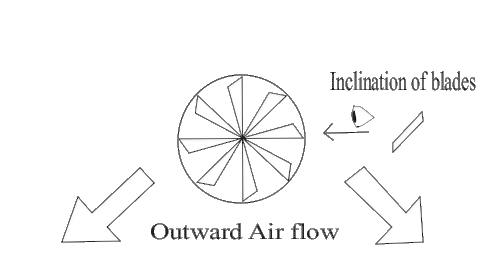
Bidirectional Turbines
A bidirectional turbine can effectively move in the same direction irrespective of the direction of the air flow. There are two ways this can be realized.
a. Having two turbines facing each other. And the shafts they are mounted on are connected to each other with gears. One turbine (and the shaft and gear connected to it) moving clockwise causes the other gear (and the other turbine) to move anti-clockwise.
When air flows outward, it drives the inner turbine. And when it flows back inwards, it drives the outer turbine. And to make the design more efficient, both turbines drive each other as they are connected with gears.
This design is easy to explain and imagine, but it is not very efficient. The gears cause huge frictional losses, which are not really necessary.
b. The blades switch their inclinations every time the direction of air flow reverses. Let's understand this, suppose the turbine blades are arranged in such a way that an outward air flow rotates the turbine clockwise. This design is currently under development to be used on ocean surface. Bidirectional wind turbines for wind power are already available. But I gave the sciencedirect.com page in references, just in case you want a look.
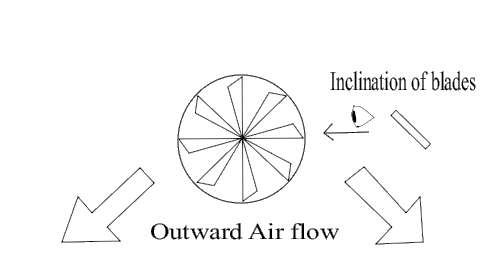
c. The most efficient design yet is the Hanna turbine, also called WETGEN. It applies both the above concepts to its design. The result is two rotors, with oppositely aligned blades mounted on a single shaft. This causes both rotors to move in the same direction irrespective of the direction of air flow. This design is still under testing but it has already proven to be 70% efficient at collecting the wave energy.
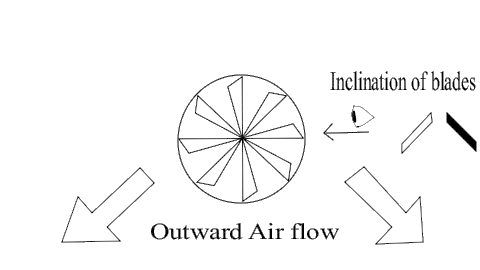
None of the the above animations are the actual designs. Their purpose is only to give you a basic idea of how they work. Or I can also say, I have sacrificed a lot of details to keep things simple for me to animate, and for you to understand the idea behind it. The original hanna or any bidirectional turbine looks nothing like this, but the working principle is same, they do work the way you can see in the animation.
Now that we have talked about the designs, let's see how much power can be gathered from these kind of devices. The most effective designs yet (doesn't employ the hanna turbine since it is still being tested). The rated power is 500 kW. This would be the ideal case, but some factors affect such a huge output. simplest example would be wind doesn't blow 24 x 7 for us to gather energy from. Over an entire year, the device can deliver us an average power supply of 131 kW. This means one device can power roughly 100 - 150 homes with maximum load of 1 kW each. The power supply changes throughout the year. Sometimes it is less than 131 kW, sometimes it is more. This is a decent number actually. An array of ten such devices can power a thousand homes for a very low cost and maintenance, and also very little pollution (we still have to manufacture the devices in factories, right?).
OWC’s can be located near the shore, on the shoreline, or even offshore. Now, we can ask questions about which location is most efficient. Since we discussed fetch in our last post, we know that waves are larger farther from the shore. How large? How much more energy can we generate if we went offshore? Our image in last post shows wave energy multiplies as we go farther from the shore. But, the answer is, it doesn’t make much of a difference, it is only 10-20% more efficient to go offshore. I’ll tell you why.
Transportation, set up, and maintenance is right now very difficult to be achieved in offshore areas. The devices need to be fixed to the sea floor (moored) properly enough so as to withstand storms and currents. The devices have GPS to track and collect them if they are blown away by the storm. Comparatively, it is cheaper and way easier to set up the devices nearshore anywhere between 10-50 m of depth. That could affect the beautiful scenery of the oceans, and be noisy. The devices can be designed with beautiful exteriors in such case, and they can be properly concealed. The devices in other two categories (to be discussed in future posts) work quite silently though.
When waves reach the shore, they get an upward push due to the inclination of the land. This phenomenon, combined with a proper design, gives us more than expected air flow to draw energy from, especially at 10-25 m depths. Such an upward push effect is most noticed during storms, if you have heard about the term “storm surge”. Hope the following animations help your imagination.
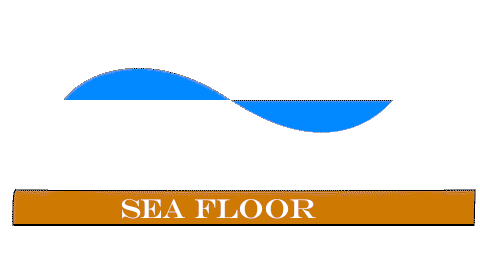
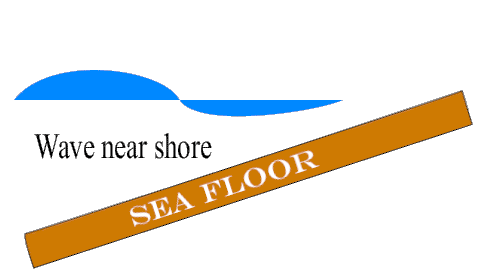
Imagine throwing a ball horizontally towards a tilted surface, our near shore sea floor for example...
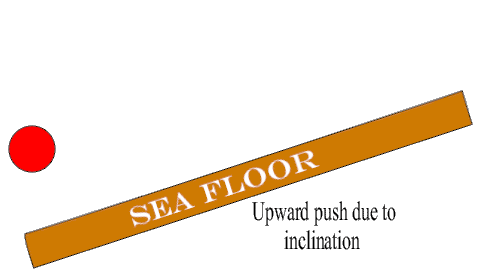
And this is how air flow for the turbine is gathered.
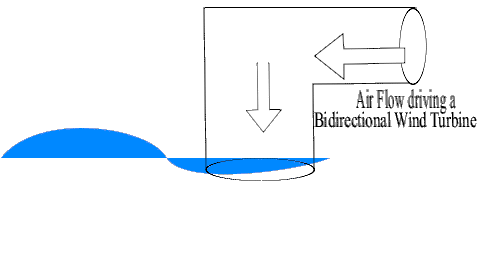
I can’t believe I wrote a thousand words on just one of the three topics. I’ll try and summarize even more in future posts, not at the expense of clear understanding though. We'll talk about oscillating body devices and overtopping devices in next post. May be more animations will help with writing fewer words. See you soon, take care.
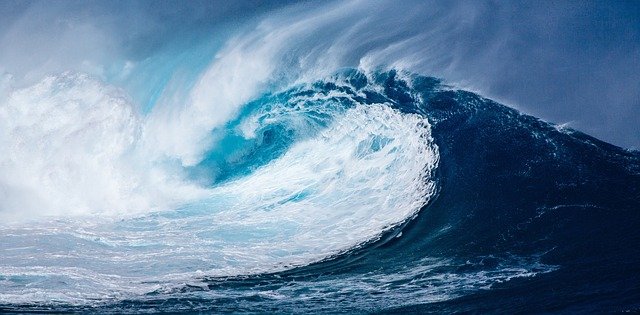
Congratulations! Your post has been selected as a daily Steemit truffle! It is listed on rank 19 of all contributions awarded today. You can find the TOP DAILY TRUFFLE PICKS HERE.
I upvoted your contribution because to my mind your post is at least 15 SBD worth and should receive 91 votes. It's now up to the lovely Steemit community to make this come true.
I am
TrufflePig, an Artificial Intelligence Bot that helps minnows and content curators using Machine Learning. If you are curious how I select content, you can find an explanation here!Have a nice day and sincerely yours,

TrufflePigDownvoting a post can decrease pending rewards and make it less visible. Common reasons:
Submit
Congratulations @pratik27! You have completed some achievement on Steemit and have been rewarded with new badge(s) :
Click on any badge to view your Board of Honor.
For more information about SteemitBoard, click here
If you no longer want to receive notifications, reply to this comment with the word
STOPDo not miss the last announcement from @steemitboard!
Downvoting a post can decrease pending rewards and make it less visible. Common reasons:
Submit
STOP
Downvoting a post can decrease pending rewards and make it less visible. Common reasons:
Submit